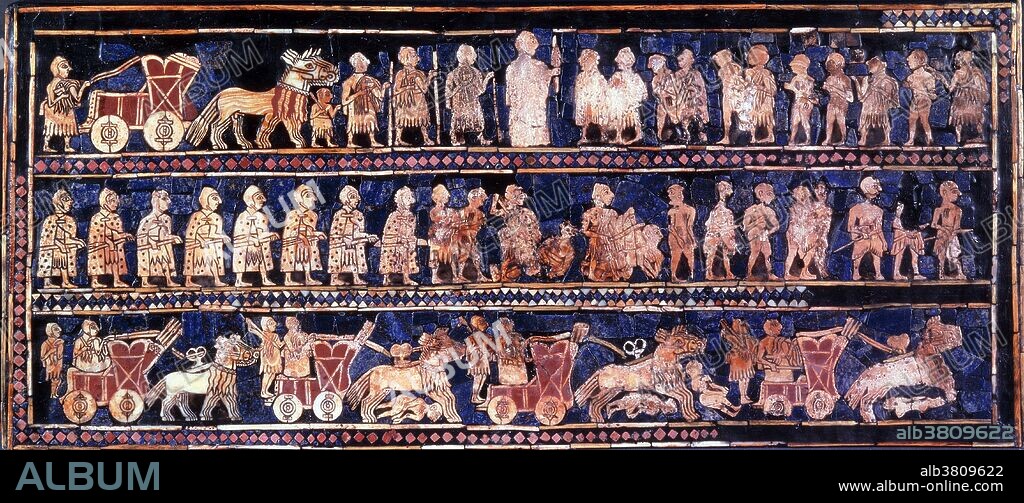alb3809622
Standard of Ur Mosaic, War Panel, 2600 BC

|
Zu einem anderen Lightbox hinzufügen |
|
Zu einem anderen Lightbox hinzufügen |



Haben Sie bereits ein Konto? Anmelden
Sie haben kein Konto? Registrieren
Dieses Bild kaufen

Titel:
Standard of Ur Mosaic, War Panel, 2600 BC
Untertitel:
Siehe automatische Übersetzung
The The Standard of Ur comes from the ancient city of Ur (modern Iraq south of Baghdad). It dates to the Early Dynastic period and is 4,600 years old. The standard was probably constructed in the form of a hollow wooden box with scenes of war and peace represented on each side through elaborately inlaid mosaics. Although interpreted as a standard by its discoverer, its original purpose remains enigmatic. It was found in a royal tomb in Ur in the 1920s next to the skeleton of a ritually sacrificed man who may have been its bearer. The war panel shows the king in the middle of the top register, standing taller than any other figure, with his head projecting out of the frame to emphasize his supreme status. In the middle register, eight virtually identically depicted soldiers give way to a battle scene, followed by a depiction of enemies being captured and led away. The lower register shows four chariots, each carrying a charioteer and a warrior (carrying either a spear or an axe) and drawn by a team of four equids.
Persönlichkeiten:
Bildnachweis:
Album / Science Source
Freigaben (Releases):
Model: Nein - Eigentum: Nein
Rechtefragen?
Rechtefragen?
Bildgröße:
5700 x 2503 px | 40.8 MB
Druckgröße:
48.3 x 21.2 cm | 19.0 x 8.3 in (300 dpi)
Schlüsselwörter:
ARCHAEOLOGIE • ARCHÄOLOGIE • ARCHÄOLOLGIE • BERÜHMT • BERÜHMTE PERSÖNLICHKEIT • FEUER, KRIEG • FRUEHZEIT • FRÜHZEIT • FÜRSTENGRAB • KOENIG • KRIEG • KRIEG: KRIEGSGEFANGENER • KRIEG: STREITWAGEN • KRIEGSGEFANGENE • KRIEGSGEFANGENER • KÖNIG • KÖNIGREICH • MESOPOTAMIAN • MOSAIK • NOTABEL • PROMINENZ • QUADRIGA • ROSSELENKER • SOLDATEN • STREITWAGEN • SUMERIAN • WAFFE • WAFFEN • WAGENLENKERIN
 Pinterest
Pinterest Twitter
Twitter Facebook
Facebook Link kopieren
Link kopieren Email
Email
